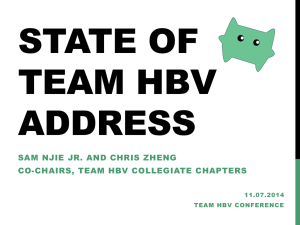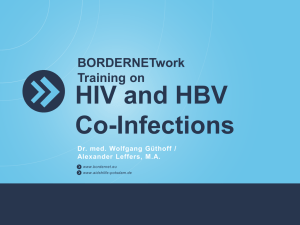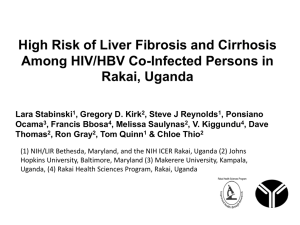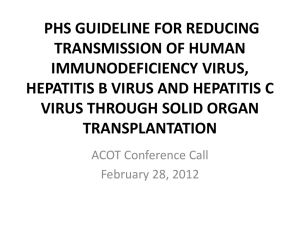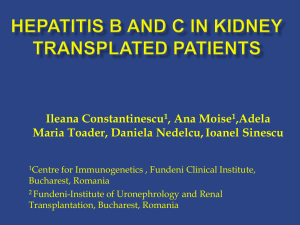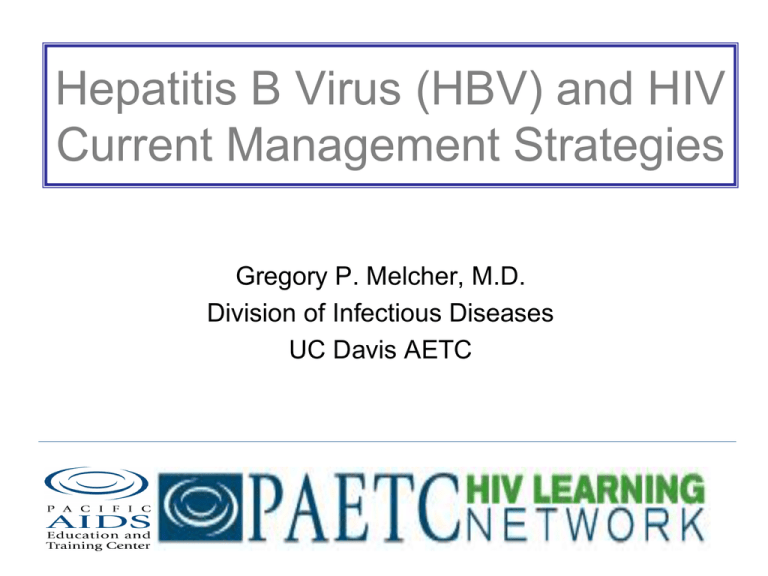
Hepatitis B Virus (HBV) and HIV
Current Management Strategies
Gregory P. Melcher, M.D.
Division of Infectious Diseases
UC Davis AETC
Hepatitis B Virus (HBV) and HIV
Current Management Strategies
•
•
•
•
•
Epidemiology
Diagnosis
Treatment
Monitoring
Vaccination
Disclosures: none
Global HBV Epidemiology
• Leading cause of chronic liver disease
• Accounts for 50% of global cases of
cirrhosis and hepatocellular carcinoma
(HCC)
• 400 million people infected; highest rates
in Asia and Africa
– 70% of adults current or past infection
– 8-15% chronic HBV infection
HBV/HIV Epidemiology
• 70-90% of HIV-infected persons in US have
evidence of past or active Hepatitis B virus
(HBV) infection
• In US, HBV most often acquired in adolescence
or adulthood via intravenous drug use (IVDU) or
sexual contact
• Spontaneous clearance in > 90%, but only in
about 45% of HIV-infected persons acutely
infected with HBV
– 20-40% of all HIV/HBV co-infected are chronic
HBV/HIV Epidemiology
• Prevalence of chronic HBV infection
among HIV-infected persons
– 5-10% HBV/HIV co-infection in US and
Western Europe
• Higher in men who have sex with men (MSM) and
IVDU
– 20-30% HBV/HIV co-infection in Asia and
parts of sub-Saharan Africa
• Chronic HBV infection develops in 90% of HBV
infected infants in Asia and sub-Saharan Africa
Interaction of HBV/HIV Coinfection
• In era of highly active antiretroviral therapy
(ART)
– Declining rates of opportunistic infections
– Prolonged lifespan for HIV-infected persons
– Increase in other diseases causing morbidity and
mortality
• End-stage liver disease (ESLD) from HBV and HCV
• Most frequent cause of death from non-AIDS defining
condition
Weber, R et al. Arch Intern Med 2006; 166:1632.
Interaction of HBV/HIV Coinfection
• Co-infected patients have higher levels of
HBV DNA, lower rates of clearance of
Hepatitis B early antigen (HBeAg)
• Increased risk of cirrhosis and ESLD
• Increased risk of hepatocellular carcinoma
(HCC) if develop cirrhosis
– Worldwide, 50% of all cases of HCC due to
HBV; 80% develop in setting of cirrhosis*
*Marcellin P, et al. www.thelancet.com http:..dx.doi.org/10.1016/S0140-6736(12)61425-1
Interaction of HBV/HIV Coinfection
• More frequent flares of hepatic enzymes
– Immune reconstitution syndrome (IRIS)
– Interruption of HIV/HBV treatment
– Development of resistance to HIV/HBV
treatment
HBV Infection Natural History
• Stages can be linear, but reversions also occur
– Immune tolerant phase – high level of HBV
replication, little or no hepatic inflammation
– Immune active phase – elevated liver enzymes and
liver inflammation on biopsy
– Inactive carrier phase – HBeAg is lost, may convert to
early antibody (HBeAb), then undergoes Hepatitis B
surface antibody (HBsAb) conversion indicating
immune control
• Small proportion remain DNA positive, “occult” HBV infection
HBV Infection Natural History
Diagnosis of HBV Infection
44 yo male
• Hepatitis B surface
antigen (HBsAg) • HBsAb • Hepatitis B core antibody
(HBcAb) IgM • HBcAb total +
Poll #1
25 yo female
• HBsAg +
• HBeAg +
• HBcAb total +
Diagnosis of HBV Infection
44 yo male
• Isolated HBcAb
– “Occult” HBV viremia
• Confirm with HBV DNA
– Waned HBsAb response
– False positive HBcAb
• Recommend HBV DNA
viral load for all patients
with isolated HBcAb total
positive
25 yo female
• Chronic HBV infection
• Define activity based on
liver enzymes and HBV
DNA level
– Immune tolerant phase vs.
immune active phase vs.
inactive carrier phase
Diagnosis of HBV Infection
Phase
HBsAg
HBcAb
total
HBeAg
HBeAb
HBsAb
HBV
DNA
Immune
active
+
+
+
-
-
+
Inactive
carrier
+
+
_
+
-
- (or low
level +)
Diagnosis of HBV Infection
32 yo male
• HBsAg • HBcAb total +
• HBsAb +
Poll #2
19 yo female
• HBsAg • HBcAb –
• HBsAb +
Diagnosis of HBV Infection
Phase
Resolved
HBV
infection
Vaccinated
HBsAg
HBcAb
IgM
HBcAb
Total
HBsAb
HBV DNA
-
-
+
+
-
-
-
-
+
-
Clinical Case
• 22 yo male with multiple unprotected
sexual encounters with men
• malaise, fatigue, anorexia
• Mild scleral icterus, tender to palpation in
RUQ
• HIV rapid test reactive
Poll #3
Clinical Case
• Serum for confirmatory Western Blot, RPR, liver
panel
– HIV RNA and genotype
• CBC for absolute lymphocyte count
– CD4 cell count
• Hepatitis panel
– HAV IgM, HBsAg, HBcAb IgM, HBcAb total, HBsAb,
HCV Ab
• Urine for GC/Chlamydia NAT, rectal and
pharyngeal culture for GC
Clinical Case
•
•
•
•
HIV Western Blot reactive
Viral load 75,150 copies/ml
CD4 cell count 750
HBsAg -, HBcAb IgM +, HBcAb total -,
HBsAb -
Poll #4
Diagnosis of HBV Infection
Phase
HBsAg
HBcAb
IgM
HBcAb
Total
HBsAb
HBV DNA
Acute HBV
infection
+
+
-
-
+
Acute HBV
“window
period”
-
+
-
-
+ or -
HBV/HIV Coinfection
• Goals of treatment
– Suppress HBV replication (HBV DNA level)
and minimize resultant hepatic damage
– Seroconversion of HBeAg to HBeAb
• Transition from active liver disease to inactive
carrier state
– Seroconversion of HBsAg to HBsAb
• Transition from inactive carrier state to resolution
of infection (rare for HIV/HBV coinfected)
HBV/HIV Coinfection
• Goals of treatment
– Prevent or reverse fibrosis/cirrhosis*
• 5 years of treatment with tenofovir – 51% had
regression of fibrosis on liver biopsy
• Virologic breakthrough rare; not due to resistance
to tenofovir
– Prevent hepatocellular carcinoma
• Indirectly through decrease in hepatic fibrosis
*Marcellin P, et al. www.thelancet.com http:..dx.doi.org/10.1016/S0140-6736(12)61425-1
HBV/HIV Coinfection
Treatment
• Prior to 2013 DHHS HIV infection
treatment guidelines revision
– HIV/HBV-coinfected persons with abnormal
alanine aminotransferase (ALT) values and
HBV DNA levels > 2,000 IU/ml
– Corresponds with active HBV infection
• Current expert opinion is to treat HIV/HBV
infection concomitantly with ART active for
both viruses if feasible
HBV/HIV Coinfection
• Treatment pitfalls
– Some HBV drugs have efficacy against HIV
and should not be used alone without full HIV
treatment regimen to prevent HIV resistance
•
•
•
•
•
Lamivudine (3TC)
Emtricitabine (FTC)
Tenofovir
Entecavir*
Telbivudine*
*denotes HBV treatment only
HBV/HIV Coinfection
Treatment
• HBV resistance
– Commonly occurs when 3TC or FTC used
alone; rare with tenofovir, entecavir
– HBV genotype can detect resistance
• Not indicated pre-treatment for naïve patients
• Failure to suppress HBV DNA or rebound
• Flare of hepatitis
– Associated with discontinuation of HBV
treatment or development of drug resistance
HBV Treatment Options
• Interferon – low HBV viral load
• Nucleoside/nucleotide analogues
– Lamivudine (3TC) and emtricitabine (FTC)
– Entecavir – potent
– Telbivudine –not indicated if 3TC/FTC failure
– Adefovir – less potent, active if 3TC resistance
– Tenofovir (TDF)
• TDF/FTC superior to TDF alone in HIV/HBV
coinfected*
*Matthews, GV CID (2013) doi:10.1093/cid/cit02
Clinical Case
• HIV infection and “window period” acute
HBV infection
• Treatment options
– Treat HIV and wait to see if HBV becomes
chronic
– Treat HIV and HBV
– Repeat serology in 6-8 weeks to see if
resolves with HBsAb
Poll #5
Clinical Case
• Repeat HBV serology 6 weeks later
– HBsAg +, HBcAb total +, HBeAg +,
HBV DNA 100, 000 copies/ml
– Immune active carrier
• DHHS HIV treatment guidelines 2013
– All preferred regimens include tenofovir (TDF)
and emtricitabine (FTC) plus either efavirenz
(EFV) or a boosted protease inhibitor
(atazanavir or darunavir) or raltegravir
Clinical Case
• Start patient on TDF/FTC/EFV (Atripla)
• At 8 weeks, no significant side effects
other than vivid dreams
• HIV RNA level 250 copies/ml
Poll #6
Monitoring HBV Treatment
• Goal: suppress HBV viral load to
undetectable
• Monitor HBV DNA level at 3-6 month
intervals
– Virologic response is > 2 log10 copies/ml
decrease from baseline at 6 months
– No role for additional anti-HBV agents if not
able to reach undetectable
Monitoring HBV Treatment
• HBeAg+
– Higher levels of HBV DNA
– Monitor for seroconversion every 3-6 months
– Unclear if able to stop HBV therapy if converts
to HBeAb
• HBsAg
– Monitor annually; rare to seroconvert
Monitoring HBV Treatment
• Elevated aminotransferases
– Chronic HVB infection
– Immune reconstitution inflammatory
syndrome (IRIS)
– Drug related liver injury
– Emergence of HBV drug resistance
HBV/HIV Coinfection and IRIS
• HBV is an immune-mediated disease
• Enhanced immunity with reconstitution of
immune system with ART
– Higher levels of HIV RNA and CD4 < 200
– Usual onset within 4-8 weeks of starting ART
– Associated with > 50 CD4 cells
• Symptoms of acute hepatitis
• Usually resolves spontaneously
HBV Drug Resistance
• Inferred when > 1 log10 copies/ml increase in
HBV DNA viral load from nadir
• Highest risk for monotherapy with either
lamivudine or emtricitabine
• Rare with entecavir
– Overlaps with lamivudine resistance
• Not reported with tenofovir
• Identify by requesting HBV resistance genotype
HCC Screening
• HCC can develop even in absence of
cirrhosis
• Screen with serum alpha-feto protein
(AFP) and hepatic ultrasound every 6-12
months
– Higher risk is for patients with HBV/HIV
coinfection; many experts recommend
screening every 6 months
Clinical Case
• Two years on TDF/FTC/EFV
– HIV RNA viral load < 20 copies/ml
– HBV DNA viral load < 40 copies/ml
– Develops renal insufficiency due to tenofovir
• What options are available for continuing
to treat both HIV and HBV infections?
HBV Treatment Options
• Interferon – low HBV viral load
• Nucleoside/nucleotide analogues
– Lamivudine and emtricitabine
– Entecavir – potent
– Telbivudine –not indicated if 3TC/FTC failure
– Adefovir – less potent, active if 3TC
resistance
– Tenofovir
Clinical Case
• HLA B5701 allele negative
• Change ART to abacavir/lamivudine
(Epzicom) + EFV
• Add entecavir 0.5 mg daily for HBV
• Repeat monitoring in 6 weeks
– HBV DNA < 40 copies/ml
– HIV RNA < 20 copies/ml
HBV Vaccination
• Recommended for all HIV infected
persons lacking HBsAb and are HBsAg• Response rates 18-71%
– Lower seroconversion rates associated with
low CD4 cell count, high HIV RNA and HCV
– Higher dose (40 mcg – 47%) vs. standard
dose (20 mcg – 34%) recommended by
experts
HBV Vaccination
• If vaccinated with CD4 cell count < 200,
may need to repeat if HBsAb < 10 IU/ml
• Check HBsAb 1-2 months after series
completed; repeat with 40 mcg dose if not
immune
• Some experts recommend annual HBsAb
testing; re-dosing if falls < 10 IU/ml
Hepatitis B Virus (HBV) and HIV
Current Management Strategies
•
•
•
•
•
Epidemiology
Diagnosis
Treatment
Monitoring
Vaccination
References
•
•
•
•
•
Hepatits B and HIV Coinfection http://hivinsite.ucsf.edu/InSite?page=kb-0503-04#S1X
Weber R, Sabin CA, Frils-Møller N, et al. Liver-related deaths in persons
infected with the human immunodeficiency virus: the D:A:D study. Arch
Intern Med. 2006 Aug 14-28;166(15):1632-41.
Zoutendijk R, Zaaijer HL, deVries-Sluijs TE, et al. Hepatits B surface
antigen decline and clearance during long-term tenofovir therapy in patients
coinfected with HBV and HIV. J Infect Dis. 2012 15 Sep; 206:974-980.
Peters MG, Koziel MJ. Viral hepatitis in HIV infection. N Engl J Med. 2007
Apr 5; 356:1445-1454.
Marcellin P, Gane E, Buti M, et al. Regression of cirrhosis during treatment
with tenofovir disoproxil fumarate for chronic hepatitis B: a 5-year open-label
follow-up study. http://dx.doi.org/10.1016/50140-6736(12)61425-1

